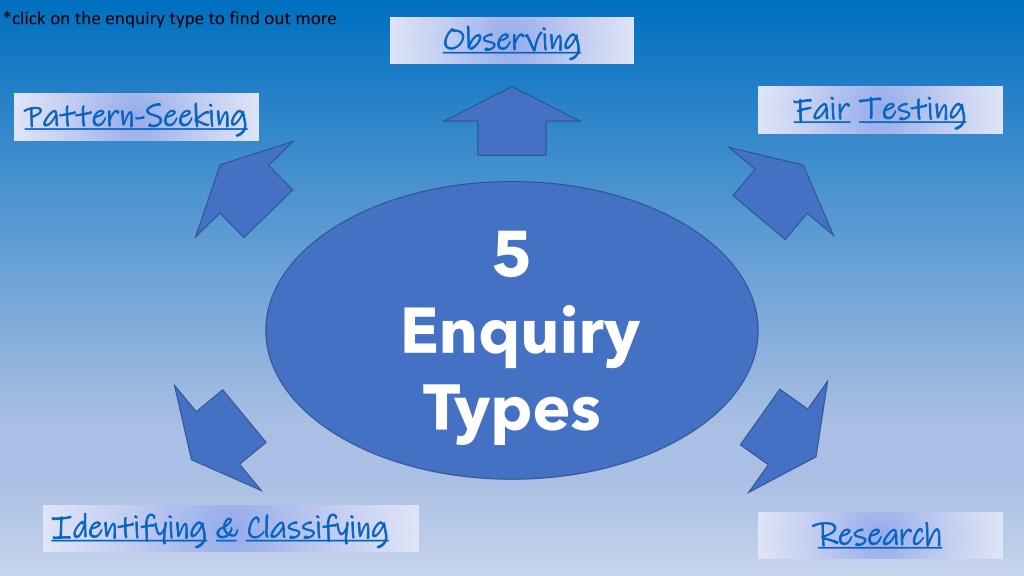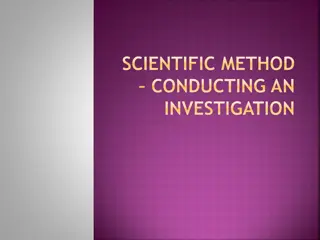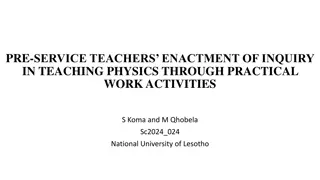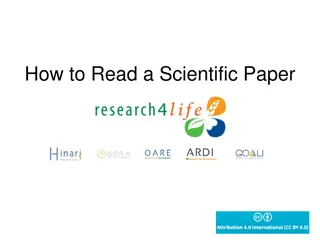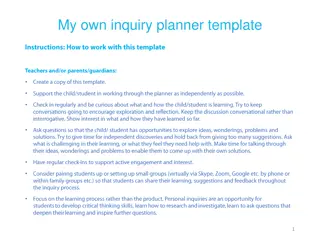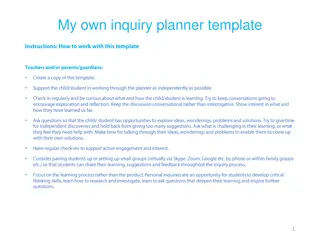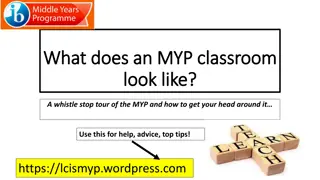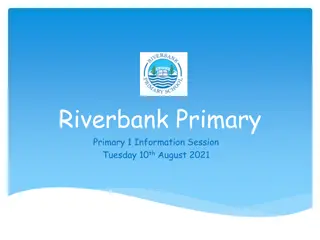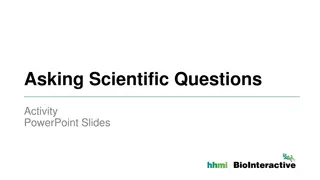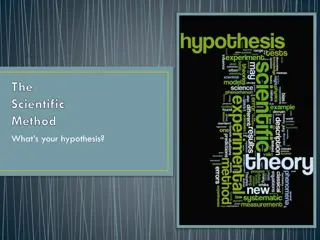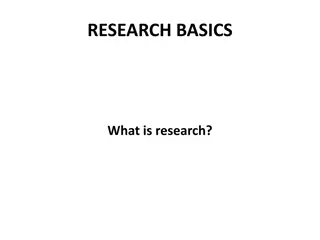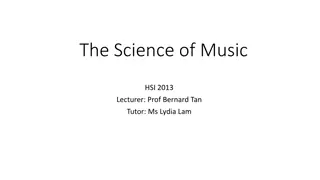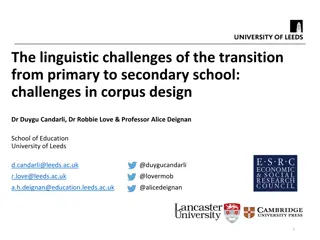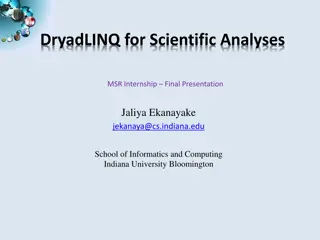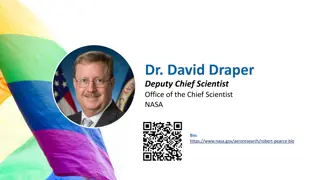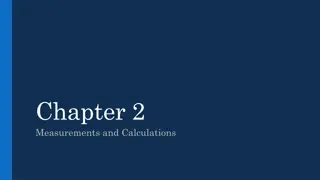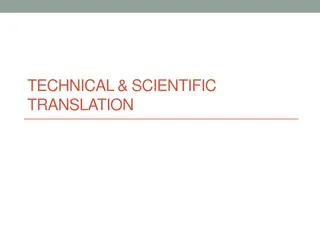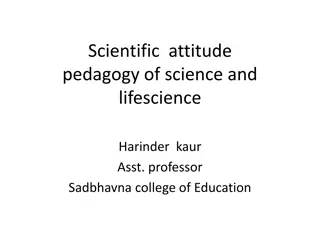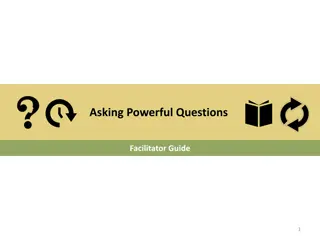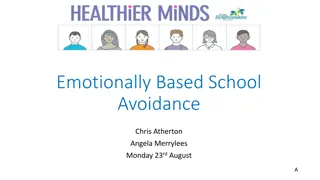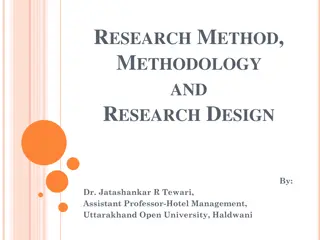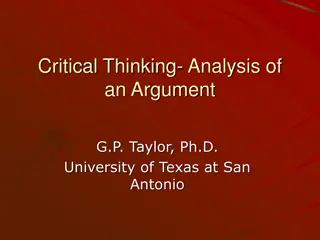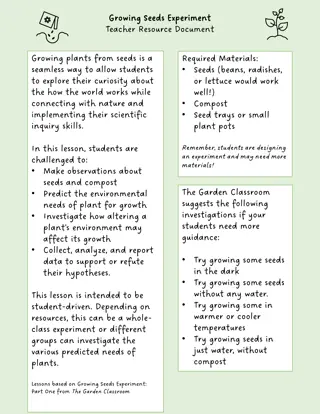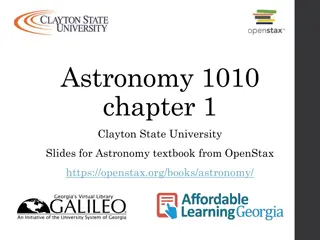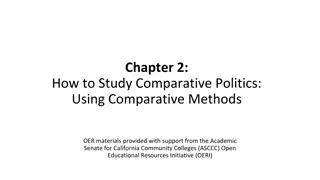Exploring Scientific Inquiry Methods for Primary School Students
Observation, fair testing, and research are essential methods for primary school students to learn scientific inquiry. Observation questions help in identifying and measuring events over time, fair test questions facilitate comparisons to understand cause and effect relationships, and research allows students to explore unanswered questions. These methods provide valuable learning opportunities and foster critical thinking skills in young learners.
Download Presentation

Please find below an Image/Link to download the presentation.
The content on the website is provided AS IS for your information and personal use only. It may not be sold, licensed, or shared on other websites without obtaining consent from the author. Download presentation by click this link. If you encounter any issues during the download, it is possible that the publisher has removed the file from their server.
E N D
Presentation Transcript
*click on the enquiry type to find out more Observing Observing Fair Fair Testing Testing Pattern Pattern- -Seeking Seeking 5 Enquiry Types Identifying Identifying & & Classifying Classifying Research Research
Observation questions allow pupils to identify and measure events and changes in a range of phenomena (living things, materials and physical process or events). These observations may take place over time spans of minutes or hours (e.g. rain drops evaporating) or, up to several weeks or months (e.g. rearing young chicks). Definition adapted from It s not fair - or is it? (Turner, Keogh, Lawrence & Naylor, 2011) Observing over time provides pupils with opportunities to: Make decisions on what and how to observe Identify, measure and record events and changes in a range of phenomena Make predictions as time passes and patterns emerge Further Reading Examples of questions for observation are: 1. What happens to a seed when it germinates? 2. What happens to bread if it s left in a damp cupboard? 3. What happens to ice in your hand? 4. What happens to your shadow during the day? 5. What happens to a plant when it is not watered? https://seerih-innovations.org/enquiringscience4all/enquiries/observing-over- time https://www.ogdentrust.com/assets/general/WS-observing-over-time.pdf https://www.bbc.co.uk/bitesize/topics/z2ddmp3/articles/zyyqfcw https://pstt.org.uk/resources/curriculum-materials/types-enquiry https://www.teachprimary.com/learning_resources/view/the-five-key- practices-every-good-primary-science-teacher-should-know
Fair test questions make comparisons, often trying to find out which is the best or most. Fair tests allow pupils to explore relationship between variables. A fair test identifies the causal relationship between two variables e.g. does the height of the ramp affect how quickly the toy car rolls down the ramp and everything else remains the same. Comparative tests allow pupils to compare one event with another e.g. does the red car go faster than the green car? Definition adapted from It s not fair - or is it? (Turner, Keogh, Lawrence & Naylor, 2011) Fair testing & making comparisons provides pupils with opportunities to: Recognise that one thing has an effect on another Recognise when tests are fair Generate fair test questions themselves Explore all the variables that may have an effect Identify variables. Identifying the differences they have noticed Know how to measure or observe the effects Further Reading https://www.ogdentrust.com/assets/general/WS-fair-tests_February-2020.pdf https://www.ogdentrust.com/assets/general/WS-comparative-testing.pdf Examples of questions for fair tests are: 1. Which material is the best for keeping Teddy dry? 2. Where will the plants grow the tallest? 3. Which is the strongest magnet? 4. What washing powder cleans a stain better? 5. Which material is the most suitable to be chosen as waterproof? https://seerih-innovations.org/enquiringscience4all/enquiries/comparative-fair- testing https://pstt.org.uk/resources/curriculum-materials/types-enquiry https://www.teachprimary.com/learning_resources/view/the-five-key- practices-every-good-primary-science-teacher-should-know
Research provides the opportunity for pupils to learn how to answer their own questions when they can t be tackled with experiments in/outside the classroom because of safety reasons or just because it is impossible. This type of enquiry helps learners Examples of questions to research are: 1. Why is most of our food stored in plastic? 2. Why is salmon in decline? 3. Why do lion s live in countries with warmer climate s? 4. Why do we find more spiders in our homes during the winter? 5. Why aren t all new car s made with solar panels to fuel them instead of petrol or electric? This type of enquiry helps learners to: evaluate sources distinguish between fact and opinion recognise conflicting evidence and bias Further Reading Sources for learners to use include: Educational visits Museums factory/industry links Visits from a real scientist to answer questions Books Internet & digital software https://www.ogdentrust.com/assets/general/WS-research.pdf https://www.theschoolrun.com/research-skills-for-children https://seerih-innovations.org/enquiringscience4all/enquiries/research-using- secondary-sources https://pstt.org.uk/resources/curriculum-materials/types-enquiry https://www.teachprimary.com/learning_resources/view/the-five-key- practices-every-good-primary-science-teacher-should-know
This type of enquiry allows pupils to understand how the world is organised and how it has different features and characteristics. Identification is the process of using differences to name something. Classification is organising things into groups. Definition adapted from It s not fair - or is it? (Turner, Keogh, Lawrence & Naylor, 2011) Identifying & classifying provides pupils with opportunities to: Compare and contrast a variety of phenomena around them Name and group features and characteristics using their observational skills Sort, identifying and classifying living and non-living things Further Reading https://www.ogdentrust.com/assets/general/WS-identifying-and-classifying.pdf Examples of questions for identifying and classifying phenomena are: 1. What types of flowers did the bees go to? 2. What types of trees are in the local forest? 3. Do all living things have four legs? 4. Do all living things have a skeleton? 5. Are all materials rigid? https://seerih-innovations.org/enquiringscience4all/enquiries/identifying- classifying-grouping https://www.stem.org.uk/news-and-views/opinions/ideas-teaching- identification-and-classification-primary-classroom https://pstt.org.uk/resources/curriculum-materials/types-enquiry https://www.teachprimary.com/learning_resources/view/the-five-key- practices-every-good-primary-science-teacher-should-know
Pattern-seeking involves conducting observations or surveys where variables aren t easily controlled, and answer the enquiry question by identifying patterns in the results. Learners can also collect and interpret data from secondary sources. They make observations and conduct surveys where the variables can t easily be controlled for practical or ethical reasons. Definition adapted from It s not fair - or is it? (Turner, Keogh, Lawrence & Naylor, 2011) Pattern seeking provides pupils with opportunities to: Plan what is needed to find out Gather information Identify patterns involved Generate informed conclusions from the emerged patterns Further Reading Examples of questions for identifying and classifying phenomena are: 1. Do all birds feed at the same time of day? 2. Which flowers do bees prefer? 3. Do all apples have the same number of seeds? 4. Do people with the longest legs jump the furthest? 5. Do we all grow at the same speed?; Is it always hot when the sun is shining? https://www.ogdentrust.com/assets/general/WS-pattern-seeking.pdf http://primaryscienceonline.org.uk/glossary-of-terms/pattern-seeking/ https://www.bbc.co.uk/bitesize/topics/z2ddmp3/articles/zw3xb82 https://pstt.org.uk/resources/curriculum-materials/types-enquiry https://www.teachprimary.com/learning_resources/view/the-five-key- practices-every-good-primary-science-teacher-should-know
Progression in Science Progression in Science Designing a broad and balanced science curriculum in your school will effectively support progression in learning. The key to ensuring this is that you provide opportunities for pupils to learn through all enquiry types. Wherever possible use the questions that pupils pose as a means to investigate. As the teacher you should facilitate the learning by ensuring the enquiry type is suitable for the learners to draw a conclusion to the question that has been posed. It is vital that the teaching of scientific knowledge is built into lessons to aid pupils understanding of concepts and patterns that occur during enquiry based learning. Pupils who have good scientific knowledge will be able to give sensible, realistic predictions and make conclusions from their enquiries that are consistent with scientific understanding. Here https://dera.ioe.ac.uk/12180/2/090916sciencelevelsposteren.pdf you will find the strands in progression from the level descriptors for science KS2 and KS3 in Wales.
Ideas for enquiry in Year 3 Ideas for enquiry in Year 3 Fair-Testing / Comparative Tests Identifying & Classifying Observation over time Pattern-seeking Research How does the length of the carnation stem affect how long it takes for the food colouring to dye the petals? How many different ways can you group our seed collection? What happens to celery when it is left in a glass of coloured water? What colour flowers do pollinating insects prefer? What are all the different ways that seeds disperse? Which body lotion makes my skin feel smoothest? How do the skeletons of different animals compare? How does our skeleton change over time? (from birth to death) Do male humans have larger skulls that female humans? Why do different types of vitamins keep us healthy and which foods can we find them in? Is there the same level of light in the evergreen wood compared with the deciduous wood? How would you group these plants and animals based on what habitat you would find them in? How does the school pond change over the year? What conditions do woodlice prefer to live in? How are the animals in Australia different to the ones that we find in Britain? Which magnet is strongest? Which materials are magnetic? If we magnetise a pin, how long does it stay magnetised for? Do magnetic materials always conduct electricity? How have our ideas about forces changed over time? How does the distance between the shadow puppet and the screen affect the size of the shadow? How would you organise these light sources into natural and artificial sources? Is the Sun the same brightness all day? Are you more likely to have bad eye sight and to wear glasses if you are older? How does the Sun make light?
Ideas for enquiry in Year 4 Ideas for enquiry in Year 4 Fair-Testing / Comparative Tests Identifying & Classifying Observation over time Pattern-seeking Research In our class, are omnivores taller than vegetarians? What are the names for all the organs involved in the digestive system? How does an egg shell change when it is left in cola? Are foods that are high in energy always high in sugar? How do dentists fix broken teeth? Does the amount of light affect how many woodlice move around? Can we use the classification keys to identify all the animals that we caught pond dipping? How does the variety of invertebrates on the school field change over the year? How has the use of insecticides affected bee population? Why are people cutting down the rainforests and what effect does that have? How does the thickness of a conducting material affect how bright the lamp is? How would you group these electrical devices based on where the electricity comes from? How long does a battery light a torch for? Which room has the most electrical sockets in a house? How does a light bulb work? How does the length of a guitar string/tuning fork affect the pitch of the sound? Which material is best to use for muffling sound in ear defenders? When is our classroom the quietest? Is there a link between how loud it is in school and the time of day? Do all animals have the same hearing range? How does the mass of a block of ice affect how long it takes to melt? How would you sort these objects/materials based on their temperature? How does the level of water in a glass change when left on the windowsill? Is there a pattern in how long it takes different sized ice lollies to melt? What are hurricanes, and why do they happen?
Ideas for enquiry in Year 5 Ideas for enquiry in Year 5 Fair-Testing / Comparative Tests Identifying & Classifying Observation over time Pattern-seeking Research How does age affect a human s reaction time? How does age affect a human s reaction time? How does a bean change as it germinates? Is there a relationship between a mammal s size and its gestation period? Why do people get grey/white hair when they get older? How does the surface area of an object affect the time it takes to sink? Can you label and name all the forces acting on the objects in each of these situations? How long does a pendulum swing for before it stops? Do all objects fall through water in the same way? How do submarines sink if they are full of air? How does the length of daylight hours change in each season? How could you organise all the objects in the solar system into groups? Can you observe and identify all the phases in the cycle of the Moon? Is there a pattern between the size of a planet and the time it takes to travel around the Sun? What unusual objects did Jocelyn Bell Burnell discover? Which type of sugar dissolves the fastest? Can you group these materials based on whether they are transparent or not? How does a container of salt water change over time? Do all stretchy materials stretch in the same way? What are microplastics and why are they harming the planet? Which material rusts fastes/slowest? Can you identify and classify these reactions and changes into reversible, and irreversible? Can you describe their groups similarities and differences? How does a nail in salt water change over time? How does the amount of bicarbonate of soda, washing up liquid and vinegar affect the reaction? What are smart materials and how can they help us?
Ideas for enquiry in Year 6 Ideas for enquiry in Year 6 Fair-Testing / Comparative Tests Identifying & Classifying Observation over time Pattern-seeking Research Which type of exercise has the greatest effect on our heart rate? Which organs of the body make up the circulation system, and where are they found? How does my heart rate change over the day? Is there a pattern between what we eat for breakfast and how fast we can run? How have our ideas about disease and medicine changed over time? Is a layer of blubber a helpful adaptation for cold- water environments? Compare the skeletons of apes, humans, and Neanderthals how are they similar, and how are they different? How has the skeleton of the horse changed over time? Is there a pattern between the size and shape of a bird s beak and the food it will eat? What ideas did American geneticist Barbara McClintock have about genes that won her a Nobel Prize? How does the temperature affect how much gas is produced by yeast? How would you make a classification key for vertebrates/invertebrates or microorganisms? What happens to a piece of bread if you leave it on the windowsill for two weeks? Do all flowers have the same number of petals? What do different types of microorganisms do? Are they always harmful? Which type of fruit makes the best fruity battery? How would you group electrical components and appliances based on what electricity makes them do? How does brightness of bulb change as the battery runs out? Does the temperature of a light bulb go up the longer it is on? How has our understanding of electricity changed over time? How does the angle that a light ray hits a plane mirror affect the angle at which it reflects off the surface? What colours do you get if you mix different colours of light together? How does my shadow change over the day? Is there a pattern to how bright it is in school over the day? And, if there is a pattern, is it the same in every classroom? How do our eyes adapt to different conditions?
